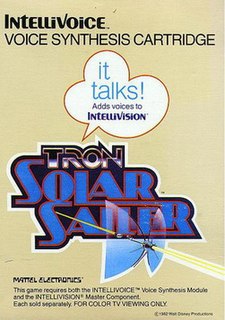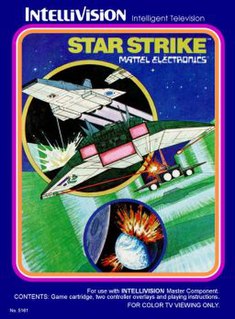
The Intellivision is a home video game console released by Mattel Electronics in 1979. The name Intellivision is a portmanteau of "intelligent television". Development of the console began in 1977, the same year as the introduction of its main competitor, the Atari 2600. In 1984 Mattel sold their video game assets to a former Mattel Electronics executive and investors who formed an entity that became INTV Corporation. Games development started in 1978 and continued until 1990 when the Intellivision was discontinued. From 1980 to 1983 over 3 million Intellivision units were sold.

BurgerTime is a 1982 arcade game created by Data East initially for its DECO Cassette System. The player is chef Peter Pepper, who must walk over hamburger ingredients located across a maze of platforms while avoiding pursuing characters.
1984 saw many sequels and prequels and several new titles such as Tetris, Karate Champ, Boulder Dash, and 1942.

Bump 'n' Jump is an overhead-view vehicular combat game created by Data East and originally released in Japan as Burnin' Rubber. The arcade version was available as both a dedicated board and as part of Data East's DECO Cassette System. It was distributed in North America by Bally Midway. The goal is to drive to the end of a level while bumping enemy vehicles into the sides of the track and jumping over large obstacles such as bodies of water.

Frogs and Flies is a 1982 video game by Mattel Electronics for the Atari 2600. It is a conversion of the Intellivision cartridge Frog Bog released earlier that year. In both games, each player controls a frog sitting on a lily pad, attempting to eat more flies than the other. Frogs and Flies is similar to the 1978 Sega-Gremlin arcade game Frogs.

Astrosmash is a fixed shooter video game for the Intellivision console, designed by John Sohl, and released by Mattel Electronics in 1981. The player uses a laser cannon to destroy falling meteors, bombs, and other targets.

Intellivision Lives! is a compilation of over 60 Intellivision video games, originally produced by Mattel Electronics and INTV Corporation between 1978 and 1990. Using original game code and software emulation, Intellivision Productions released the first edition in December 1998 on a Windows and Macintosh hybrid CD-ROM. A sequel, Intellivision Rocks, was released in 2001 that includes third-party games originally published by Activision and Imagic as well as Mattel Electronics Intellivoice and ECS games. Versions of Intellivision Lives! were then released for the PlayStation 2, Xbox, and Nintendo GameCube by Crave Entertainment. In 2010 Virtual Play Games released a Nintendo DS edition.

Intellivision World Series Major League Baseball is a baseball sports game (1983), designed by Don Daglow and Eddie Dombrower and published by Mattel for the Intellivision Entertainment Computer System. IWSB was one of the first sports games to use multiple camera angles and present a three-dimensional perspective. It was also the first statistics-based baseball simulation game on a video game console; all prior console baseball games were arcade-style recreations of the sport.

Advanced Dungeons & Dragons: Treasure of Tarmin is a video game for the Intellivision video game console and the Mattel Aquarius computer system. This game was a licensed Dungeons & Dragons adaptation.
Lock 'n' Chase (ロック・ン・チェイス) is a video game developed by Data East and released in arcades in Japan in 1981. It was licensed to Taito for distribution in North America. A maze game, Lock 'n' Chase was Data East's response to Pac-Man. Home versions for the Intellivision and Atari 2600 were published by Mattel in 1982 and an Apple II version in January 1983.

Night Stalker is a top-down maze shooter designed by Steve Montero and released for the Intellivision console in 1982. Night Stalker was ported to the Atari 2600 as Dark Cavern and released under Mattel's M Network label. Apple II and IBM PC versions were published in 1983.
PlayCable was an online service introduced in 1980 that allowed local cable television system operators to send games for the Intellivision over cable wires alongside normal television signals. Through the service, subscribers would use a device, called the PlayCable adapter, to download the games for play on their Intellivision. It was the first service that allowed users to download games for play on a video game console. PlayCable was not widely adopted, due in part to high costs for users and operators, as well as limitations of the PlayCable adapter. The service was discontinued in 1983.

TRON: Solar Sailer is a game that was released by Mattel for Intellivision in 1982. The game is one of four released for the console that required the Intellivoice module.

Adventures of Tron is a platform video game produced by Mattel in 1982 and the Atari 2600 version of the Intellivision video game Tron: Maze-A-Tron. It is based on the Disney film Tron. Following the loss of the license, the game was re-released as Adventures on GX-12.
Tron is an American science fiction media franchise created by Steven Lisberger, which began with the eponymous 1982 film. The original film portrays Jeff Bridges as Kevin Flynn, a genius computer programmer and video game developer who becomes transported inside a digital virtual reality known as "The Grid", where he interacts with programs in his quest to escape.

Armor Battle is a multiplayer video game released by Mattel for its Intellivision console in 1979. One of the earliest titles available for Intellivision, Armor Battle pits two players against each other in a contest to see which player can eliminate their opponent's stock of tanks first.

Baseball is a multiplayer sports video game produced by Mattel and released for the Intellivision home video game system in 1980. As the best-selling title in the console's history, with over 1 million copies sold, Baseball put players in control of a nine-man baseball team competing in a standard nine-inning game. When first released, Mattel obtained a license from Major League Baseball, although the only trademarked item used was the MLB logo on the game's box art. No official team names or player names were used in the game.

Triple Action is an action video game produced by Mattel Electronics for its Intellivision video game system in 1981. The game actually includes three separate games—racing, tank combat and flying—where two players compete against each other for the best score.

Star Strike is a single-player video game, released by Mattel for its Intellivision video game system in 1981. The Intellivision's best-selling game in 1982, with over 800,000 copies sold, Star Strike was inspired by the attack on the Death Star in the 1977 film Star Wars. The player must drop bombs on alien weapons silos before Earth moves into range.

M Network was a video game division of Mattel that, in the 1980s, produced games in cartridge format for the Atari 2600 video game system.
















